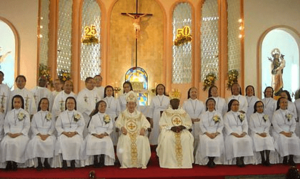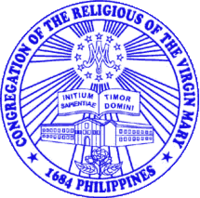Religious of the Virgin Mary facts for kids
|
Religiosas de la Beata Virgen María
|
|
 |
|
| Abbreviation | RVM |
|---|---|
| Established | 1684 |
| Type | Centralized Religious Institute of Consecrated Life of Pontifical Right for women |
| Purpose | To seek the greater service and honor of God |
| Headquarters | Motherhouse 214 N. Domingo St., Brgy. Kaunlaran, Cubao, Quezon City Philippines |
|
Members
|
702 members as of 2020 |
|
Motto
|
Latin: Ad Jesum Cum Maria English: To Jesus with Mary |
|
Foundress
|
Venerable Mother Ignacia del Espíritu Santo Iuco, RVM |
|
Superior General
|
Very Rev. Mother Maria Rosabella R. Gallo, R.V.M. |
|
Countries served
|
|
|
Parent organization
|
Catholic Church |
| Website | RVM |
| Remarks | Works include primary through tertiary education, spiritual retreats, direct service to the poor, and assistance at hospitals and various diocesan and parish works. |
|
Formerly called
|
Beaterio de la Compania de Jesus |
The Congregation of the Religious of the Virgin Mary (Spanish: Religiosas de la Beata Virgen María, often called RVM) is a Catholic group of religious sisters. It was started in Manila, Philippines, in 1684. The founder was a Filipina woman named Venerable Mother Ignacia del Espíritu Santo.
As of 2016, there were over 700 RVM sisters, mostly from the Philippines. They manage a university and 58 other schools. They also work in seven countries outside the Philippines. From the beginning, they focused on helping others and offering spiritual retreats.
Contents
History of the RVM Sisters
The Congregation of the Religious of the Virgin Mary is the oldest and largest Filipina Catholic religious group. It was the first group of all-Filipina religious sisters in the Philippines. Mother Ignacia del Espíritu Santo founded it in 1684.
This group aims to help its members grow in their faith. They do this by offering Catholic education to young people. They also teach about faith in churches. Additionally, they provide spiritual retreats for women and run dormitories. They also care for sick people in hospitals.
Early Beginnings in the Spanish Era
Ignacia del Espíritu Santo started her work in 1684. She decided on her path after a spiritual retreat led by a Jesuit priest named Pablo Clain. At 21, she left her home to start a group of religious sisters. This was unusual because most sisters stayed in convents back then. She began with her niece and two other young girls. This small group was called the Beatas de la Compania de Jesús. Later, it became the Congregation of the Religious of the Virgin Mary (RVM). People often called them beatas, meaning "saintly women."
The house where the beatas lived was known as the House of Retreat. This was because they also offered retreats and days of prayer for women. Mother Ignacia's kindness and practical approach attracted more people to the group. In 1732, the Archbishop of Manila Juan Ángel Rodríguez approved their rules. Mother Ignacia, then 69, stepped down from her leadership role. By 1748, the group had fifty members. They ran a school for 45 girls, including Filipinas, Spaniards, and mestizas (people of mixed heritage). They taught Christian living, reading, sewing, and embroidery. In July 1748, the Archbishop asked King Ferdinand VI of Spain to officially protect the Congregation. Mother Ignacia died two months later, on September 10, 1748, at 85. On November 25, 1755, the King granted the Congregation civil protection.
Growing and Expanding Their Work
From 1748 to 1770, the beatas helped Jesuit priests lead spiritual retreats. They also expanded their work to other areas in Luzon, the largest island in the Philippines. They traveled in small groups to help people strengthen their faith.
Between 1872 and 1900, the RVM sisters started their first missions in Mindanao. Mindanao was a long journey by sea back then. In 1874, the beatas were first called Sisters when they sailed to Tamontaca in Cotabato. Despite dangers, the Sisters set up in other Jesuit mission towns. They opened missions in Dapitan in 1880, Dipolog in 1892, Zamboanga in 1894, and Surigao, Lubungan, and Butuan in 1896.
During the Philippine Revolution of 1896 and the Spanish–American War, the Sisters in Mindanao faced difficulties. However, they cared for wounded people in hospitals. When peace returned, they opened new schools in Luzon and the Visayas.
Changes During the American Period and World War II
On June 21, 1902, the leader of the Archdiocese of Manila, Martin García Alocer, allowed the sisters to elect a new leader. That same year, María Efigenia Álvarez was chosen as the first mother general. On March 17, 1907, Pope Pius X praised the Congregation's rules. Pope Pius XI officially approved them on March 24, 1931. This approval meant the Congregation was now directly under the Pope's authority.
With Efigenia as mother general in 1902, the Congregation grew a lot. She encouraged the sisters to study at the University of Santo Tomas to become better teachers. During her time, ten new houses, schools, and dormitories were started. In 1938, Efigenia, at 80 years old, was allowed to retire. On July 10, 1938, María Andrea Montejo took over. She managed the 26 houses the Congregation had across the country. In 1939, the Congregation moved its training center for new sisters from Parañaque to its current location in Quezon City.
After Philippine Independence
The Philippines became fully independent from the United States on July 4, 1946. Almost two years later, on January 12, 1948, Pope Pius XII gave the final approval for the Congregation's rules. This placed the RVM directly under the authority of Rome.
After the war, the Congregation expanded across the entire Philippine archipelago. In 1948, they opened a college in Davao City. This college has since grown into the University of the Immaculate Conception. By 1963, the Congregation had 483 fully committed Sisters, 40 new sisters in training, and 9 aspiring sisters.
The 50th anniversary of the Religious of the Virgin Mary in the United States was celebrated in Sacramento, California, on July 18, 2009. The Philippines' celebration that year was held at Our Lady of the Assumption Chapel.
The RVM Sisters Today
By 2016, there were over 700 RVM sisters around the world. They managed 58 schools, including one in Islamabad, Pakistan, and four in Ghana, West Africa. While mostly involved in education, they also had ten retreat houses and fifteen dormitories. They also helped people during disasters and those in great need. The sisters were involved in many special ministries, serving churches, hospitals, and other community needs. They had a presence in the United States, Canada, Indonesia, Ghana, Italy, Taiwan, Sweden, and Pakistan. In Italy, they have convents, and in Taiwan, they care for senior citizens with Alzheimer's disease.
Mother Ignacia's Special Recognition
In 2007, Pope Benedict XVI declared the founder, Ignacia del Espiritu Santo, a Venerable of the Catholic Church. This means she is recognized for living a life of great faith and goodness.
RVM Motherhouse and Headquarters
The RVM Congregation, once called the Beaterio de la Compañia de Jesus, was first located in Intramuros, Manila. In 1935, a historical marker was placed there.
The original beaterio was damaged during World War II. This led the Congregation to move to a new location. The Bagumbayan Light and Sound Museum now stands where the old beaterio was.
The current main headquarters, or motherhouse, is in Quezon City. It is the successor to the first motherhouse in Intramuros. That first house existed from 1684 until it was destroyed in 1945 during the Liberation of Manila. For some time during and after the war, the motherhouse was on Espania Street in Manila. In 1950, it moved to Quezon City. This large compound includes the chapel of Our Lady of the Assumption, St. Mary's novitiate (for new sisters), juniorate (for younger sisters), and infirmary (for sick sisters). Near the front gate is the Betania Retreat House. Sisters return to the motherhouse for gatherings and their yearly 8-day retreat.
The RVM Seal: What it Means
The official seal of the Congregation is inspired by Mary, the Mother of God. It has rays around it, showing their wide-reaching care and kindness. In the center is the A and M monogram. This stands for Auspice Maria, which means "under the guidance of Mary" or "Hail Mary." Around the Auspice Maria are twelve stars. These represent twelve special gifts of Mary, through which people receive her blessings. Rays come out from the stars in seven groups. These show the graces that come from Jesus with Mary. They also represent the Congregation's motto, "To Jesus with Mary."
Below the monogram is an open book with the Latin words Ad Jesum Cum Maria. This translates to "To Jesus with Mary." Right below the book is a picture of the original Beaterio building in Intramuros before the war. Its strong look represents the strength and unity that led Ignacia del Espiritu Santo to start the first Filipina congregation of women in the Philippines.
Below the Beaterio is a sprig of sampaguita flowers. The sampaguita (J. sambac) has been the national flower of the Philippines since 1934. It shows that the Congregation is from the Philippines and serves the country and Filipinos living overseas.
Images for kids
See also
- Chapel of San Lorenzo Ruiz, New York
- Pontificio Collegio Filippino
- Jerónima de la Asunción
- Three Fertility Saints of Obando, Bulacan, Philippines
- The First Filipina Nun
- Colegio de San Pascual Baylon











